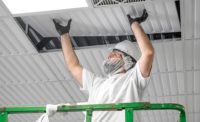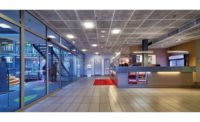The stage design team of Blue Ridge Community Church in Forest, VA is always looking for new ideas, particularly materials that work well with light. A group of volunteers with a flair for construction, they create innovative stage backdrops every 6-12 months under the leadership of Andrew Hunt, Elder and Technical Arts Pastor. One of the most successful was a luminous wall made of a translucent thermoformed ceiling panels.
When one of the team members discovered transluminous panels online, an idea began to form: What if we hung translucent ceiling panels vertically, to form a wall lit from behind?
They found black T-bar ceiling suspension grid at a local supplier, and hung lengths of it vertically. The lightweight T-bars were tied at their top ends to a stage rigging bar overhead, then suspended with their bottom ends about 12 inches above the floor. The grid’s horizontal cross-Ts were added while it was hanging in place. No additional framing was needed to keep it together and hanging vertically.
Hunt selected Ceilume’s Convex pattern, a deeply three-dimensional panel shaped like a broadly truncated pyramid that protrudes about two inches out of the grid plane. For added visual interest, they installed half the panels protruding towards the audience and alternating panels inverted, pointing away from the congregation. The 24 inch x 24 inch ceiling panels fit into the vertical grid just as they would in a horizontal ceiling application.
The wall was divided into five sections, with the largest one at the center, 14 feet wide by 18 feet tall. Each section was populated with panels to form triangular peaks that suggest cathedral arches. The sections were separated by black columns two feet wide that had been built for a previous design.
Lighting
Lights, placed at the back wall of the stage, included 25 of Blizzard Lighting’s Hotbox EXAs. The luminous wall hung about 12 inches in front of the lights. Even at that short distance, the translucent panels provide smooth diffusion of the light.
Backlit, the faceted panels have a gemlike appearance, and the wall becomes a glowing array of different-colored planes. On most set designs, “we’re concerned with is how to get light to shine from the back side,” explains Hunt, “and those tiles worked perfectly. The way that they interacted with different colors of light on the whole tile worked really well.”
The lighting system is controlled by DMX controllers, which can select the colors of the LEDS, and can be pre-programmed with complete lighting set-ups that can be changed on cue. DMX can even synchronize the lights to the music, so they pulse like a disco light system, but Blue Ridge’s lighting was mostly changed just a few times during a service, typically through slow fades at the ends of songs. They also threw some front lighting on the wall occasionally. Although it effectively enhanced worship, it was “not a super flashy light show,” says Hunt.
In a typical, horizontal suspended T-bar grid ceiling, the panels are kept in place by gravity. With the grid rotated vertically, something needed to be added to hold the panels in position. The design team came up with a clever solution involving 1-inch binder clips. They placed a panel in the grid, then clamped a binder-clip onto the center fin of the Tee on the back side of the frame, and pushed the clip’s wire handles forward so they pressed against the flange of the ceiling panel. The panels are lightweight, and the pressure of the little clip-handles was strong enough to hold them. (The team was unaware that special hold-down clips usually used to restrain panels in rooms where there may be wind uplift, could also have worked.)
A Portable Luminous Wall
Blue Ridge Community Church has a second campus that meets in a school gymnasium. To maintain continuity between the two locations, they built a smaller, modular version of the luminous wall that could be easily set up for Sundays and then stored out of the way the rest of the week. It was composed of six freestanding T-bar grid frames, each two feet wide by eight feet high, containing translucent panels. The frames could be lined up to form a continuous wall, or separated into individual columns of light. The verticals Tees were cut with an extra six inches on the bottom to act as legs. The frames were stood on end and then leaned back against a wall, with lights located in the wedge of space behind the frames.
Although the tiles are lightweight and fairly flexible, they are extremely strong. “Without the tiles,” recalls Hunt, “the grid was super flimsy. After we added the tiles, they were rock solid.” In the same way that the individual tiles nest closely (for efficient shipping), the free-standing frames could be stacked nested together when not in use. After Sunday worship, they were just picked up and tucked away out of sight backstage for the rest of the school-week.
Wall installations at each campus were successfully used weekly for about a year. They were surprisingly durable, even the portable wall, which Hunt had expected to be destroyed by repeated moving. When the team developed a new stage design, the walls were still in excellent condition. The hanging wall was taken down “very meticulously” so it could be re-used. Both the grid and tiles are reusable (and recyclable), and the tiles can be washed if they become dirty or stained. The disassembled wall was donated to a church with fewer resources in a nearby town where it continues to provide an inspiring light for worship.




